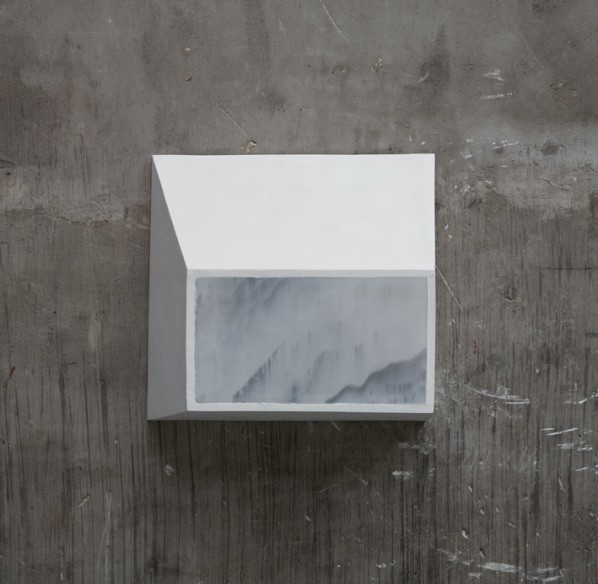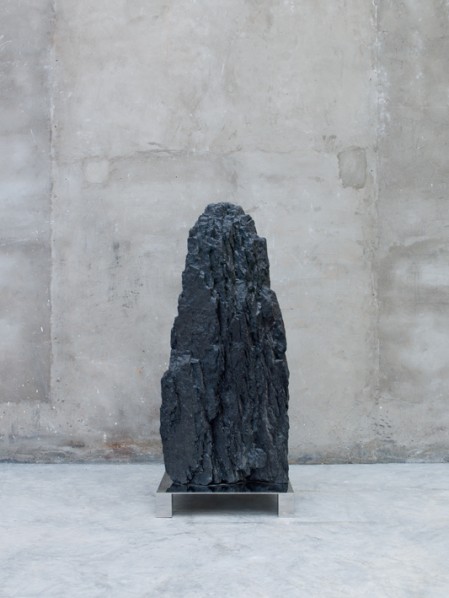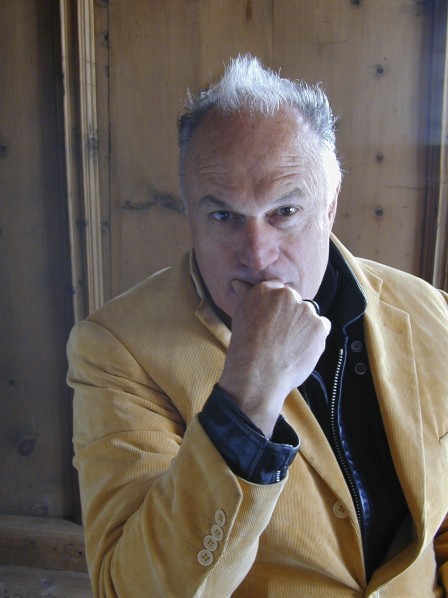
Not Vital, Landscape, 2011; marble, plaster, 54 x 57.2 x 25.5cm
Courtesy the artist and Galerie Urs Meile, Beijing-Lucerne
Galerie Urs Meile is pleased to present guarda 看, the second solo show of Swiss artist Not Vital (*1948) at their Beijing gallery.
Set across all four of the gallery’s exhibition spaces, Vital has conceived a multi-layered landscape field, a hybrid of manmade and natural materials that examines the intersection between these two polarities. This constructed environment evokes both the outer and inner human self—simultaneously presenting an opportunity of internal retreat and yet confounding that hope with stark reminders of urban modernity.
Facing the viewer across the largest of the gallery spaces, a series of blackened mountains, hewn from coal, dominate the room. Towering over the viewer at almost 2 metres in height, their imposing density and bulk demands confrontation and contemplation. These are ‘portraits’ of a particular mountain, Piz Nair (2013), from Vital’s native Engadin valley in Switzerland. Vital has spent much of his life in perpetual intercontinental travel, yet for periods of each year he returns to his home village of Sent, Switzerland. A lifetime of gazing at the surrounding mountains has permanently imprinted their impressions onto his visual memory. Yet now Beijing is also a home and workplace for Vital, and his choice of material also speaks of this adopted base. For not only is China the world’s largest producer of coal, but the material stands as representative of arduous labour and the progress of industry—qualities that Vital greatly admires. These rough, dense forms are presented on gleaming steel bases, underlining the works as a finished product, an emblem of polished modernity. Yet paradoxically, mountains also possess potent spiritual symbolism—the Sacred Mountains of China are traditionally known as sites of pilgrimage for emperors. These forms are thus laden with powerful meanings beyond their physical substance and being. Both in scale and voice, a grouping of Vital’s Dali stone marble works occupies a significantly quieter presence, mounted in an installation across both the walls and floor of the second gallery space. Upon discovering the extraordinary qualities of China’s renowned Dali stone in 2012, Vital began to create works from sections cut from the marble, presenting each on individually sculpted plaster bases that vacillate between symmetry and asymmetry, yet create a cohesively harmonious unit. Each delicately veined marble surface presents a lyrical mass of undulating linear forms that sketch an amalgam of natural formations, recalling the formal elegance of traditional Chinese ink drawings. These abstracted landscape fields are some of Vital’s most subtle to date, being predominantly white in appearance, and their titles, such as Glacier (2013) and Ice (2013), reflect this. Again, Vital recalls his native Engadin valley, where for many months of the year the mountaintops remain shrouded in ice and snow, resembling the smooth, cold faces of the marble stones.

Not Vital, Piz Nair, 2011; coal, 165x55x70cm
Courtesy the artist and Galerie Urs Meile, Beijing-Lucerne
The sole figurative presence throughout the exhibition is that of a commanding, outsized portrait head, isolated and planted directly onto the floor. Like the landscapes, the choice of material employed by the artist refutes traditional representational approaches within this genre. Despite the soft, lustrous curves of the egg-like form, the hard, metallic finish in which the depiction is rendered creates a distinct alienation from those that encounter it. The facial features of this impassive witness are indicated but not explicitly explored, both attracting and repelling any potential encounter.
A monumental staircase, formed from stainless steel, is a striking focus of the exhibition, occupying a whole exhibition space. Rising from floor to ceiling, the suggested ascendant motion recalls rites and rituals. Indeed, the staircase also echoes the staircases that accompany Vital’s House to Watch the Sunset (2005), built in Agadez, Niger. On this structure, each of the staircases on the three levels of the building lead to a single room in which one contemplates the magnificent setting sun. Yet somewhat frustratingly, in this instance the staircase leads to no such immediate visual reward, but is instead emblematic of an implied journey. Indeed, throughout these landscapes that Vital creates, there is no figure represented within them; instead, the viewer is the implied participant. Perhaps the artist is suggesting that it is the imagined journey and experience, and not the explicitly described one that can be the most potent.

Portrait of Not Vital by Beny Steiner
Courtesy the artist and Galerie Urs Meile, Beijing-Lucerne
This meditative space extends to the gallery’s outer courtyard, where Vital presents a new body of sculptures entitled Ŏu (藕) (2013). Each stainless steel sculpture depicts a simple cross-section of interlaid and overlapping lotus roots (rhizomes). Being indigenous to China, the lotus plant is indeed a ubiquitous sight across the country, yet it stands apart as being richly imbued with symbolic meaning, religious and otherwise. In Buddhism, the lotus connotes purity of the heart and mind, being one of the Eight Auspicious Symbols of Buddhism. The structure of the lotus, rooted in the earth at its base and rising to the peak with its pristine white flower, is held as a symbolic representation of the philosophical pathway from base materialism to enlightenment.
Guarda, meaning in Romansch ‘to look at’, invites one to spend time engaged in prolonged encounter with the field that Vital presents here, quiet and yet immensely striking. Both Eastern and Western art historical canons have traditionally held the representation of landscapes as not simply indicative of a straightforward depiction, but also as the symbolic embodiment of states of mind, both of the individual artist and as widely emblematic of mankind. A landscape represents a literal and metaphysical breathing space, an opportunity for contemplation and meditation. This delicately orchestrated body of sculptural work offers a multiplicity of ‘journeys’ for the viewers’ exploration, should they choose to become immersed in these potential pathways.
Text by Rukhsana Jahangir
About the exhibition
Exhibition in Beijing: 16. 11. 2013– 19. 1. 2014
Opening: Saturday, November 16, 2013, 16-19h
Venue: Galerie Urs Meile Beijing
Address: No. 104 Caochangdi, Chaoyang district, 100015 Beijing, China
T +86 (0)10 643 333 93, F +86 (0)10 643 302 03
Courtesy the artist and Galerie Urs Meile Beijing, for further information please visit www.galerieursmeile.com.




























